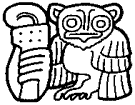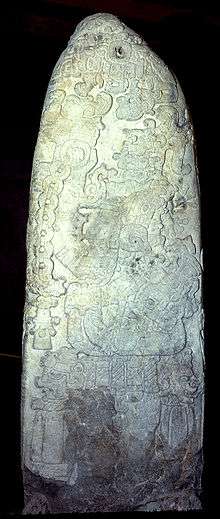Spearthrower Owl
Atlatl Cauac, translated as "Spearthrower Owl" (364 – 439 AD) is the name commonly given to a Mesoamerican personage from the Early Classic period, who is identified in Maya inscriptions and iconography. It has been suggested that Spearthrower Owl was a ruler of Teotihuacan at the start of height of its influence across Mesoamerica in the 4th and 5th century, and that he was responsible for the introduction of Teotihuacan-related cultural traits in the Maya area.[1]
Name

"Spearthrower Owl" is a name invented by archaeologists to describe the Teotihuacan-originated spear-holding owl symbol, stylised as one or two Maya glyphs usually used to represent his name.
The symbols themselves are not readable Maya writing, even though inserted among otherwise normal glyphs. However, in Tikal, the name appears written once as an ordinary Maya glyph compound that can be spelled out. The suggested spelling for the name is Jatz'om Kuh, meaning "owl that will strike".[3] This also looks like a verbal description of the atlatl-holding owl symbol.
Various logographs or glyphs depicting an owl and a spear-thrower are documented in Teotihuacan and in the Maya cities of Tikal, Uaxactun, Yaxchilan, and Toniná. They may or may not refer to the same individual, or have other symbolic meanings.
Biography

Maya inscriptions at several sites describe the arrival of strangers from the west, depicted with Teotihuacan-style garments and carrying weapons. These arrivals are connected to changes in political leadership at several of the sites.
Inscriptions on the Marcador monument at the Petén Basin center of Tikal record that Spearthrower Owl ascended to the throne of an unspecified polity on a date equivalent to 4 May 374. Monuments at El Peru, Tikal and/or Uaxactun describe the arrival of a personage Siyaj K'ak' somehow under the auspices of Spearthrower Owl in the month of January 378. The exact date of his arrival in Tikal is identical with the death of the Tikal ruler, Chak Tok Ich'aak I. Tikal Stela 31 describes that in 379, a year after the arrival of Siyaj K'ak' at Tikal, Yax Nuun Ayiin, described as a son of Spearthrower Owl and not of the previous ruler Chak Tok Ich'aak, was installed as king of Tikal. His rule saw the introduction of Teotihuacan-style imagery in the iconography of Tikal. Stela 31 was erected during the reign of Yax Nuun Ayiin's son Siyaj Chan K'awil and describes the death of that ruler's grandfather, Spearthrower Owl, in 439 AD (Maya date 9.0.3.9.18).[4]
Spearthrower Owl was mentioned in later texts; for example, on a door lintel of Temple One where the Tikal ruler Jasaw Chan K'awiil I celebrated the thirteen k'atun (13x20x360 days) anniversary (in 695 A.D.) of Spearthrower Owl's death by "conjuring the holy one."[5]
Interpretations
The connection of Spearthrower Owl to Teotihuacan as well as the precise nature of Teotihuacan's influence on the Maya has been a hotly debated topic since the hieroglyphic texts first became fully readable in the 1990s. The controversy is related to the general discussion of central Mexican influence in the Maya area which was sparked by the findings of Teotihuacan-related objects in the early Maya site of Kaminaljuyú in the 1930s. The controversy has two sides. The internalist side argues for limited direct contact between Teotihuacan and the Maya area. This side has been represented by epigraphers such as Linda Schele and David Freidel who have argued that the Maya merely had friendly diplomatic relations with Teotihuacan which caused the Maya elite to emulate Teotihuacano culture and ideology.[6] The externalist side argues that Teotihuacan was an important factor in the development of Maya culture and politics in the Classic period. This viewpoint was first associated with archaeologist William Sanders who argued for an extreme externalist viewpoint.[7] But as more evidence of direct Teotihuacan influence in the Maya area surged at Copán and new hieroglyphic decipherments by epigraphers such as David Stuart interpreted Teotihuacan incursion as a military invasion, the externalist position was strengthened. In 2003, George Cowgill an archaeologist specialising in Teotihuacan who had formerly espoused a mostly internalist perspective on Teotihuacan-Maya relations, summarised the debate, conceding that Teotihuacan had probably exercised some kind of political control in the Maya area in the early classic period and that left an important legacy into the late and epi-classic periods.[8]
In 2008 an interpretation of Spearthrower Owl-related iconography at Teotihuacan suggested that Spearthrower Owl was an important military god at Teotihuacan that had his given name to both a place known as "Spearthrower Owl Hill" and to the ruler mentioned in the Maya hieroglyphic texts.[9]
Notes
- ↑ Stuart (1998)
- ↑ Mesoweb, Drawing and translation after Martin and Grube (2000)
- ↑ Spearthrower Owl Hill: A Toponym at Atatelco, Teotihuacan. Jesper Nielsen and Christopher Helmke. Latin American Antiquity 19(4), 2008, pp. 459-474. See also The Updated Preliminary Classic Maya - English, English - Classic Maya Vocabulary of Hieroglyphic Readings by Eric Boot. Mesoweb resources 2007.
- ↑ Some Working Notes on the Text of Tikal Stela 31, David Stuart, 2011
- ↑ "The arrival of strangers", David Stuart, 1998
- ↑ Freidel; Schele; Parker (1995): p. 161-175.
- ↑ e.g. Cheek (1977)
- ↑ Cowgill "Teotihuacan and Early Classic Interaction: A Perspective from Outside the Maya Region" chapter in Braswell (2003)
- ↑ Nielsen & Helmke 2008
References
- Braswell, Geoffrey E. (2003). "Introduction: Reinterpreting Early Classic Interaction". In Geoffrey E. Braswell (ed.). The Maya and Teotihuacan: Reinterpreting Early Classic Interaction. Austin: University of Texas Press. pp. 1&ndash, 44. ISBN 0-292-70587-5. OCLC 49936017.
- Stuart, David (1998). ""The Arrival of Strangers": Teotihuacan and Tollan in Classic Maya History" (Extract of October 1996 paper). PARI Online Publications: Newsletter # 25. Precolumbian Art Research Institute. Retrieved 2007-01-18.
- Cheek, Charles D. (1977). "Excavations at the Palangana and the Acropolis, Kaminaljuyu". In William T. Sanders and Joseph W. Michels (eds.). Teotihuacan and Kaminaljuyu: a Study in Prehistoric Culture Contact. University Park: Pennsylvania State University Press. pp. 1&ndash, 204. ISBN 0-271-00529-7. OCLC 3327234.
- Freidel, David A.; Linda Schele; Joy Parker (1995). Maya Cosmos: Three Thousand Years on the Shaman's Path (Reissue ed.). New York: Harper Paperbacks. ISBN 0-688-14069-6.
- Nielsen, Jesper; Christophe Helmke. "Spearthrower Owl Hill: A Toponym at Atetelco, Teotihuacan". Latin American Antiquity. 19 (4): 459–474.